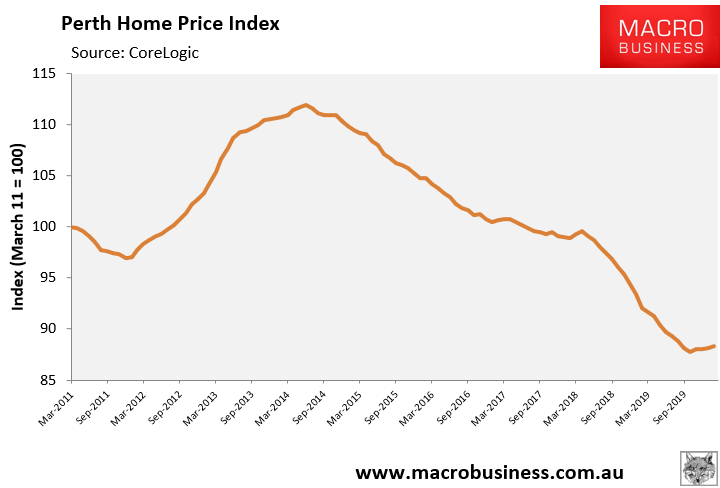Following yesterday’s report covering the five major capitals, CoreLogic has released its full dwelling value results for March, which also captures the smaller markets and regional areas:

As shown above, the smaller capitals and regions also had positive month in March, with all recording rises alongside 0.7% growth nationally.
However, Tim Lawless noted that “recent trends in the market have become less relevant as we move into a period of unprecedented uncertainty which is likely to impact further on household confidence and drag Australia’s economy into a recession for the first time in almost 30 years”:
“The housing market won’t be immune to a drop in sentiment and weaker economy, however the extent of the impact on dwelling values remains highly uncertain. Capital growth trends will be contingent on how long it takes to contain the virus, and whether additional constraints on business or personal activity are introduced.”
From a transactional perspective, Tim Lawless said, “we are expecting the number of residential property sales to fall dramatically over the coming months – a consequence of tanking consumer confidence, a rising jobless rate, and more cautious lending practices. Restrictions on open homes and on-site auctions will compound the slowdown in buyer activity, as would any future policy announcements related to peripheral services such as building and pest inspections, conveyancing and furniture removals.”
“Considering the temporary nature of this crisis, along with unprecedented levels of government stimulus, leniency from lenders for distressed borrowers and record low interest rates, housing values are likely to more be insulated than sales activity,” said Mr Lawless.
He said, “The extent of any fall in housing values is impossible to fathom without first understanding the length of time this health and economic crisis persists. Arguably, the longer it takes to contain the virus and bring economic operations back to normal, the higher the downside risk to housing values”…
Timely indicators of market activity are foreshadowing a substantial reduction in listing activity ahead. Real estate agent reports generated across CoreLogic platforms, utilised by around 70% of real estate agents for their research and pre-listing reports, have more than halved over recent weeks, implying a substantial drop in listings activity over coming weeks.
Similarly, recent polling of real estate agency enquiry levels indicated that more than 60% of Australian real estate agents have seen buyer and seller enquiries fall by more than 50% over recent weeks, with the larger majority expecting a further drop in enquiry over coming weeks.
Tim Lawless said, “If we are correct in our expectation that housing market activity is set to temporarily plunge, we could see increased volatility and a reduction in certainty creep into housing market measurements until activity picks up.
Measures of housing values and prices rely on timely updates of recently sold properties; a material slowdown in turnover is likely to create some challenges over the coming months in how we report on market conditions”…
“The outlook for housing values is less certain. Leniency from the banks for borrowers facing financial hardship should help to stymie the number of distressed properties hitting the market. Similarly, the massive federal and state government stimulus packages will help to support job retention and incomes. Also, the temporary nature of this crisis implies that most home owners will do their best to weather the storm, hoping for an eventual upside as the virus is contained and economic conditions improve.”
“No doubt there is a rising level of downside risk to housing values which is compounded by the fragile state of household balance sheets, which on average, are heavily leveraged. The wildcard remains the sheer uncertainty of how long this health crisis and associated economic disruption will persist.”
Tim Lawless concluded delivery of today’s results: “Once the virus is contained, we expect economic conditions to quickly improve, driving a turnaround in consumer spirits which should flow through to housing market activity. When that will be, remains highly uncertain.”
With widespread business closures anticipated, unemployment is likely to remain high well into 2021.
According to Westpac chief economist, Bill Evans:
“…the unemployment rate holds at 11% in the September quarter and then moves a little below 9% by the end of 2020 and then towards 8% by end 2021”.
Bloomberg Economics economist, James McIntyre, noted similar:
“The labor market dislocation will be substantial, and is likely to linger for an extended period, even though economic growth may ‘bounce back”…
Any housing rebound will be muted with mass unemployment and falling wages. Mortgage rates are also already at their lower bound, thus no further reductions will be forthcoming to rescue the housing market.
Perth provides a useful insight into what is facing Australian property amid chronic high unemployment and falling income:

Perth’s house prices are down around 21% from peak over 5.5 years.
And this is with an unemployment rate that peaked at only 6.9%.
Join the dots.

